What are sliding doors?
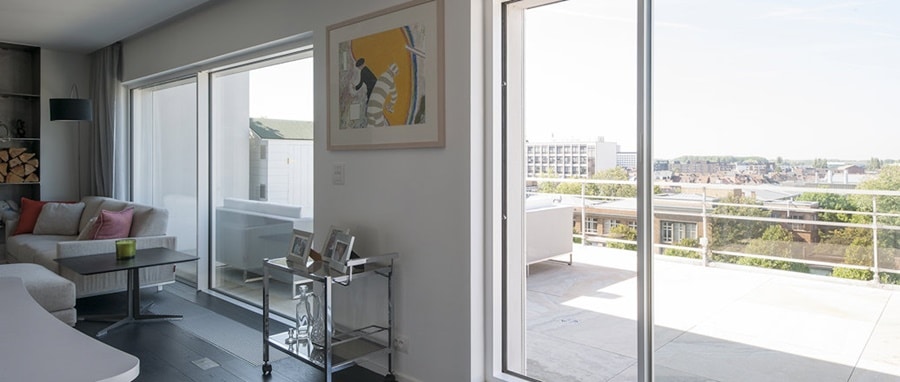
Sliding doors are a type of door design where the door panels slide horizontally along a track or rails rather than swinging open on hinges. They are often used in residential and commercial settings as a space-saving solution since they don’t require the same clearance as traditional hinged doors.
There are several types of sliding doors, including:
- Single sliding doors: One door panel slides along a track, usually parallel to a wall or another fixed panel.
- Double sliding doors have two door panels that slide in opposite directions, meeting in the middle when closed.
- Pocket doors are sliding doors that disappear into a recess or “pocket” in the wall when fully open, saving even more space.
- Bypass doors: These are often used for closets and consist of two or more door panels that slide on parallel tracks, allowing the doors to pass in front of or behind each other.
- Barn doors: A popular trend in interior design, sliding doors with a rustic or industrial aesthetic slide on an exposed track mounted on the wall above the doorway.
Sliding doors can be made from various materials, including wood, glass, metal, and composite materials, and may also feature a range of locking mechanisms and hardware styles. They can be used for interior or exterior applications, such as patio doors, closet doors, room dividers, and more.
How does a sliding door work?
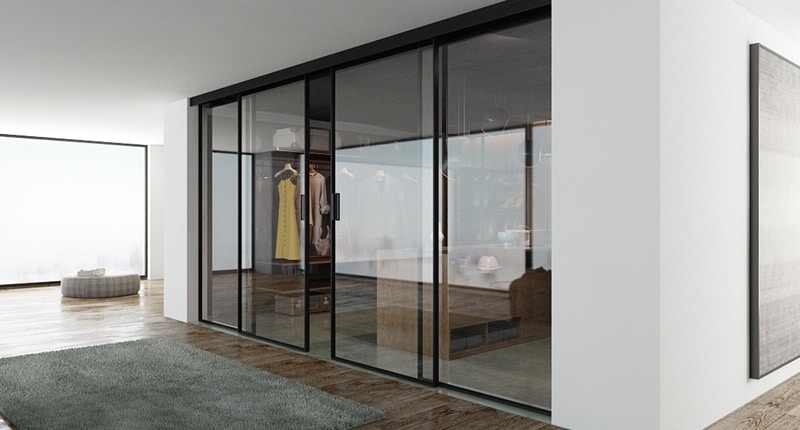
A sliding door works through a combination of tracks or rails, rollers, and door panels that allow the door to move horizontally, either parallel to a wall or along a fixed panel. The basic components of a sliding door system are:
- Door panel(s): The actual door that slides, typically made from materials like wood, glass, metal, or composite materials. Sometimes, there might be multiple panels, such as in double sliding doors or bypass doors.
- Tracks or rails: These guides along which the door panel moves. Tracks are usually installed on the floor, the top of the doorway, or both, providing support and stability for the sliding movement. They can be made of metal, plastic, or other materials, and their design can vary depending on the type of sliding door.
- Rollers or wheels: These are attached to the door panel’s top and bottom edges, allowing it to glide smoothly along the tracks. Rollers can be made of various materials, such as metal, plastic, or nylon, and may be adjustable to ensure proper alignment and smooth operation.
- Stops or bumpers prevent the door from sliding off the tracks at either end and cushion the impact when the door reaches the end of its travel. Stops can be built into the track system or installed separately.
- Handles and locks: Sliding doors may have a variety of handle designs and locking mechanisms, depending on their intended use and the level of security required.
To operate a sliding door, grasp the handle and gently push or pull the door panel along the tracks. The rollers help the door glide smoothly, while the tracks ensure the door remains properly aligned and stable during movement. When the door is fully open or closed, stops prevent it from going too far, potentially causing damage or injury.
What is the best lubricant for sliding glass doors?
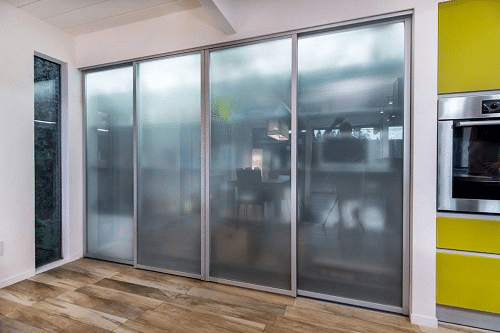
The best lubricant for sliding glass doors reduces friction, ensures smooth operation, and doesn’t attract dirt or debris that could cause the tracks or rollers to become clogged. Some popular options for lubricating sliding glass doors include:
- Silicone-based lubricants are generally the most recommended option for sliding glass doors. Silicone lubricants are water-resistant, don’t attract dirt or dust, and work well with plastic or metal components. They also don’t leave a sticky residue and can be used in various temperatures.
- Dry Teflon (PTFE) lubricants provide a thin, dry film that reduces friction and doesn’t attract dirt or dust. They are suitable for use on metal and plastic components and can help extend the life of the sliding door hardware.
- Graphite powder: This dry lubricant is another option for sliding glass doors, particularly for metal components such as rollers and tracks. Graphite powder doesn’t attract dirt or dust and can withstand various temperatures. However, applying it can be messy and may not be the best choice for areas where cleanliness is a priority.
Clean the tracks and rollers thoroughly before applying the lubricant when lubricating a sliding glass door. Remove debris, dirt, or old lubricant using a vacuum, brush, or cloth. Once the components are clean, apply the chosen lubricant according to the manufacturer’s instructions, ensuring it reaches the rollers and other moving parts.
Remember to maintain your sliding glass doors regularly, including cleaning and lubricating the tracks and rollers as needed, to ensure smooth operation and extend the lifespan of the hardware.
What blinds are best for sliding doors?
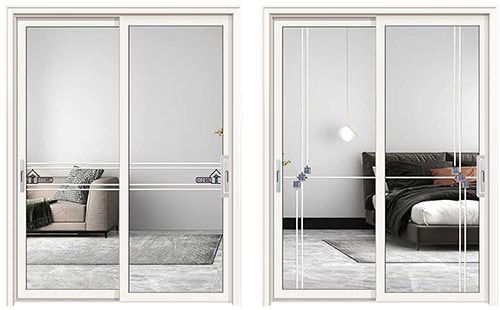
When choosing blinds for sliding doors, it’s important to consider functionality, aesthetics, and ease of use. Some popular options for sliding door window treatments include:
- Vertical blinds: Vertical blinds are a popular choice for sliding doors because they slide in the same direction as the door, allowing easy access. They are available in various materials, such as fabric, vinyl, or faux wood, and can be adjusted to control light and privacy.
- Panel track blinds: Also known as sliding panel blinds, these consist of wide fabric or woven wood panels that slide on a track system. They offer a sleek, modern look and can be easily customized to match your interior design. Panel track blinds can be fully opened or closed to control light and privacy and don’t obstruct the door when opened.
- Cellular shades: These shades, also known as honeycomb shades, can be mounted vertically for sliding doors. Cellular shades offer excellent insulation, helping to regulate indoor temperatures and reduce energy costs. They are available in various light-filtering and blackout options, allowing you to control the light and privacy in your space.
- Sheer vertical shades: Combining the functionality of vertical blinds with the soft look of sheer fabric, sheer vertical shades provide light control and privacy while maintaining a soft, elegant appearance. They are well-suited for sliding doors in living rooms, dining rooms, or other areas where aesthetics are important.
- Roller shades: Although not specifically designed for sliding doors, roller shades can be used if mounted above the door frame with enough clearance for the door to slide behind the shade. Roller shades come in various fabrics, colors, and light-filtering options, making them versatile for sliding door window treatments.
When selecting blinds for sliding doors, consider factors such as the size of the door, the amount of natural light you want to let in, the level of privacy you desire, and the overall design of the room. Measure the door and surrounding space accurately to ensure a proper fit and easy operation.
What are the best window treatments for sliding glass doors?
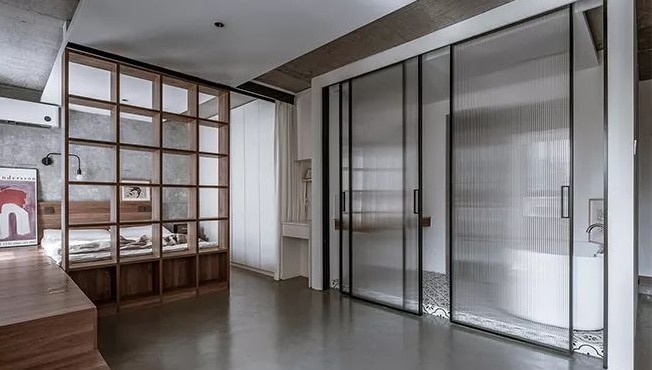
When choosing window treatments for sliding glass doors, consider functionality, ease of use, light control, privacy, and aesthetics. Some popular options for sliding glass door window treatments include:
- Vertical blinds: Vertical blinds are a practical choice for sliding glass doors because they slide in the same direction as the door, allowing easy access. They come in various materials like fabric, vinyl, or faux wood and can be adjusted for light control and privacy.
- Panel track blinds: Also known as sliding panel blinds, these consist of wide fabric or woven wood panels that slide on a track system. They offer a contemporary look and can be customized to complement your interior design. Panel track blinds can be fully opened or closed to control light and privacy.
- Cellular shades: Cellular shades, or honeycomb shades, can be installed vertically for sliding glass doors. They provide excellent insulation, helping to regulate indoor temperatures and reduce energy costs. Cellular shades are available in various light-filtering and blackout options to control light and privacy.
- Sheer vertical shades: Sheer vertical shades combine the functionality of vertical blinds with the soft appearance of sheer fabric. They provide light control and privacy while maintaining an elegant look, making them suitable for sliding doors in living rooms, dining rooms, or other areas where aesthetics are important.
- Roller shades: While not specifically designed for sliding glass doors, roller shades can be used if mounted above the door frame with enough clearance for the door to slide behind the shade. Roller shades are available in various fabrics, colors, and light-filtering options, making them versatile for sliding glass door window treatments.
- Curtains or drapes: Curtains or drapes can be an attractive option for sliding glass doors, adding a soft, decorative touch to the room. They can be mounted on a traverse or decorative rod with rings, allowing them to slide open and closed easily. Choose from various fabrics, patterns, and styles to match your décor, desired light control, and privacy level.
When selecting window treatments for sliding glass doors, consider the door size, the desired amount of natural light, the level of privacy you need, and the room’s overall design. Accurate door and surrounding space measurements are essential for proper fit and functionality.
Which type of door lock is best for sliding doors?
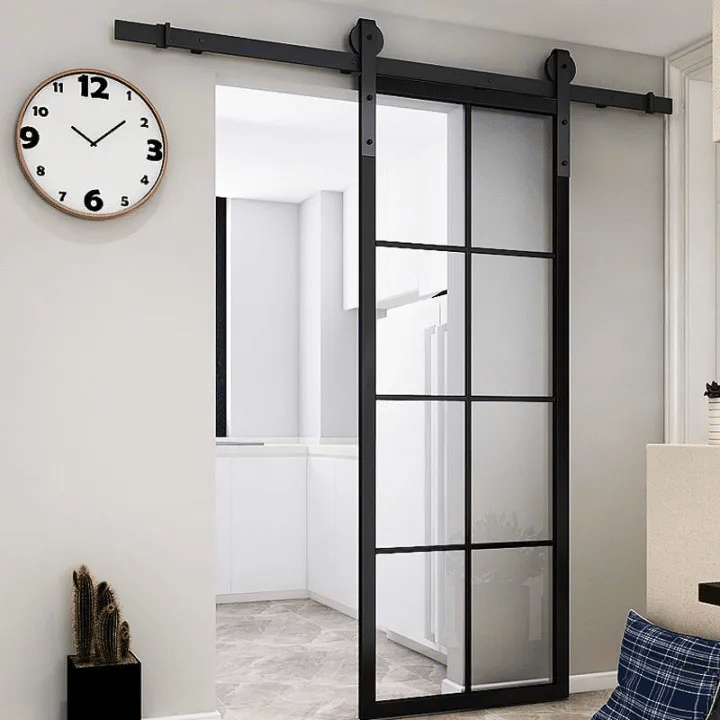
The best type of door lock for sliding doors depends on the level of security you require, ease of use, and aesthetics. Some popular and effective lock options for sliding doors include:
- Keyed locks: These locks provide a higher level of security, as they require a key to lock and unlock the door. Keyed locks are typically installed on the sliding door’s handle or near the doorjamb. They can be used on both interior and exterior sliding doors.
- Foot-operated locks: These are installed at the bottom of the sliding door and are engaged by pressing a foot pedal or lever. They are easy to use and provide an extra layer of security, especially for doors that don’t have a built-in locking mechanism.
- Security bars or rods: These are adjustable metal bars placed in the door track to prevent the door from being opened from the outside. Security bars can be a simple and cost-effective solution for securing sliding doors, although they may not be as aesthetically pleasing as other options.
- Double-bolt locks secure the door by anchoring it to the doorjamb with two bolts. They are more difficult to tamper with than traditional latch locks and provide higher security.
- Smart locks: Smart door locks can be used with some sliding doors, offering keyless entry and remote control through a smartphone app or compatible smart home system. These locks can provide added convenience and security features such as monitoring door status and receiving notifications when the door is unlocked.
When choosing a lock for your sliding door, consider the level of security you need, the ease of use, and how the lock will fit in with your door’s design. You may also want to consult a professional locksmith or security expert for the best lock. Remember to regularly maintain your sliding door and its locking mechanism to ensure smooth operation and security.

